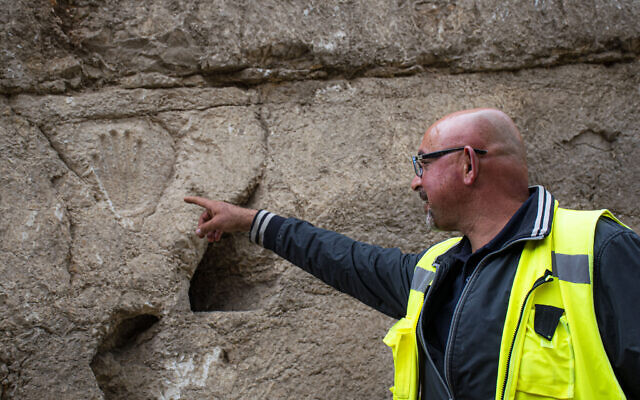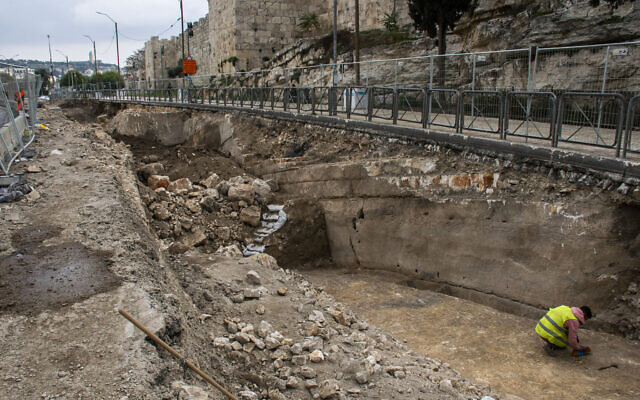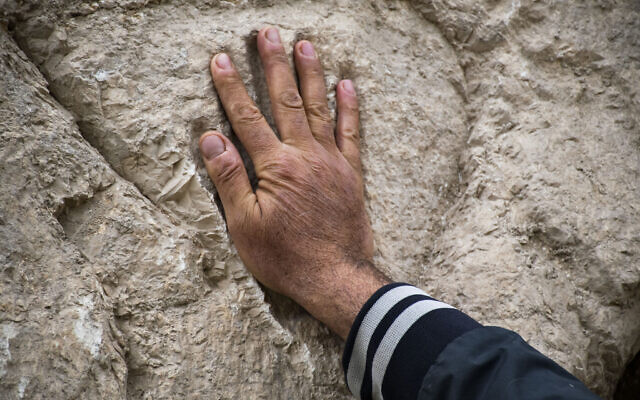I became your enemy because I tell you the truth
“You can fool some of the people all the time and all the people some of the time, but you can’t fool all the people all the time.” A. Lincoln
Archaeologists baffled as they uncover new elements of Old City fortifications, including parts of a huge rock-hewn trench; discoveries made during infrastructure work
A mysterious hand imprint was discovered carved into a 1,000-year-old dry moat that surrounded Jerusalem’s Old City during excavations of defensive fortifications, the Israel Antiquities Authority said in a statement Wednesday.
The archaeological work, carried out as part of an infrastructure project along Sultan Suleiman Street, which runs adjacent to the city walls, revealed a deep rock-hewn moat likely dating from the 10th century, or possibly even earlier, the IAA said.
At one point along the moat’s wall was a handprint carved into the stone, leaving archaeologists baffled as to its purpose.
“Does it symbolize something? Does it point to a specific nearby element? Or is it just a local prank? Time may tell,” researchers said in the statement.
The moat, at least 10 meters wide (approximately 33 feet) and two to seven meters deep (6-23 feet), encircled the whole of Jerusalem at the time, explained Zubair Adawi, Israel Antiquities Authority excavation director.
“People are not aware that this busy street is built directly over a huge moat, an enormous rock-hewn channel,” he said. “Its function was to prevent the enemy besieging Jerusalem from approaching the walls and breaking into the city.”

Unlike moats surrounding many European castles, the Jerusalem moat was left dry, but its depth and breadth would still have slowed down an approaching army.
So strong were the defenses that it took the Crusader army that arrived in June 1099 some five weeks to cross the moat as Jewish and Muslim defenders fought back, said Amit Re’em, Jerusalem regional director at the IAA.
The stone walls of the Old City that are visible today were built in the sixteenth century by Turkish Ottoman Sultan Suleiman I the Magnificent.
However, earlier fortifications around the ancient city were much stronger.
“In the eras of knights’ battles, swords, arrows, and charging cavalry, the fortifications of Jerusalem were formidable and complex, comprising walls and elements to hold off large armies storming the city,” Re’em said. “Armies trying to capture the city in the Middle Ages had to cross the deep moat and behind it two additional thick fortification walls, while the defenders of the city on the walls rained fire and sulfur down on them.”
Burning sulfur, which produces noxious fumes, was used to deter invaders.
The moat also had secret tunnels enabling defenders to rush out and attack the approaching army before slipping back behind the fortifications. Such tunnels have been uncovered in previous excavations.

“Many dreamed about and fought for Jerusalem, and the city fortifications are a silent testimony,” said IAA director Eli Escuzido.
“The archaeological finds enable us to visualize the dramatic events and the upheavals that the city underwent,” he said.
Escuzido said the IAA will try to make the discoveries available for public viewing.
All it takes for Evil to triumph is for good people to do nothing
VIDEO: MEIR KAKHANE. I DID NOT WRITE THIS, I DID NOT SAID THIS
https://www.timesofisrael.com/mysterious-handprint-found-in-1000-year-old-jerusalem-defensive-moat/?utm_source=The+Daily+Edition&utm_campaign=daily-edition-2023-01-25&utm_medium=email
Michael Loyman

